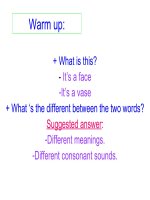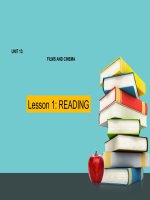Unit 13. Films and cinema
Bạn đang xem bản rút gọn của tài liệu. Xem và tải ngay bản đầy đủ của tài liệu tại đây (119.79 KB, 4 trang )
<span class='text_page_counter'>(1)</span><div class='page_container' data-page=1>
<b>Date: 7/3/2017</b>
<b>Teacher: Đỗ Thị Nguyệt Thu</b>
<b>Trainer: Võ Trần Huyền Trang</b>
<b>UNIT 13: FILMS AND CINEMA</b>
<b>LESSON A: READING</b>
<b> Class: 10 No. of students:</b>
<b>Period: Date of teaching:</b>
<b>I. Objectives: </b>
By the end of the lesson, Students will be able to:
- Master some words related to film topic
- Get more understanding about film: some kinds of film, and film’s history as well
- Read to get specific information to answer the question.
- Develop skills: listening, writing.
<b>II. Teaching aids: textbook, projector, handout, laptop,…</b>
<b>III. Procedure:</b>
<b>Time</b> <b>Contents and Stages </b> <b>T’s activities</b> <b>Ss’ activities</b>
<b>5’</b> <b>I.</b> <b>Warm up: Kim’s game</b>
Tom and Jerry
The Descendants of the sun (Hậu duệ mặt trời)
Tấm Cám chuyện chưa kể
Tây du ký
Tây Sơn hào kiệt
The journey of flowers (Hoa Thiên Cốt)
- Lead to new lesson:
- Introduce section A: Reading
<b>- Divide class into 2 </b>
groups A and B.
- Show pictures of
some films with the
name.
- Ask Ss go to the
board and write
down the name they
remember.
- Check
understanding:
+Do you go to the
board and write the
name of the film?
- Checks and gives
feedback.
- “There are some
famous films.
Today, we are going
to study Unit 13:
Films and cinema.”
- Ask Ss:
<b>- Look at the </b>
screen.
- Remember
its name and
write on the
board.
- Answer:
Yes, I do.
- Listen
- Listen.
</div>
<span class='text_page_counter'>(2)</span><div class='page_container' data-page=2>
+“Do you like
watching film?”
+ “Do you want to
see a film at the
cineme or on TV?”
+Can you name
some of the films
you have seen?”
+ “How about the
history of cinema?
You know?”
-Give instruction: “
“You don’t know
how films began and
developed. Don’t
worry! Now, we are
going to read the
passage to
understand more
about its history_
section A: Reading.”
- Listen
<b>8’</b> <b>II.</b> <b>Pre-reading</b>
<i><b>* Pre-reading vocabulary:</b></i>
1. sequence ['si:kwəns] (n): series of related
events or actions: chuỗi nối tiếp, trình tự
2. decade [ 'dekeid] (n): a period of ten years:
Thập kỷ
3. scene [si:n] (n): a part of a film: cảnh
4. audience ['ɔ:diəns] (n): watcher, viewer: Khán
giả
5. rapidly ['ræpidli] (adv)= quickly and in a short
time: nhanh chóng, mau lẹ
6. character ['kỉriktə] (n): a person in a film: nhân
vật
<i><b>* Task 1: Decide these statements are true (T) </b></i>
<i><b>or false (F).</b></i>
1. The history of cinema began at the end of the
19th<sub> century.</sub>
2. In early days, films were little more than
moving photographs, always about one
- Run through these
statements.
- Ask Ss guess these
statements are true
- Copy into
notebook
</div>
<span class='text_page_counter'>(3)</span><div class='page_container' data-page=3>
minute in length.
3. By 1905, films were about five or ten minutes
long.
4. At the end of the 1920s, the sound was
introduced.
or false.
- Write Ss’prediction
on the board.
<b>8’</b>
<b>12’</b>
<b>III.</b> <b>While-reading</b>
<i><b>* Task 1: Decide these statements are true (T) </b></i>
<i><b>or false (F).</b></i>
1. The history of cinema began at the end of the
19th<sub> century.</sub>
2. In early days, films were little more than
moving photographs, always about one minute in
length.
3. By 1905, films were about five or ten minutes
long.
4. At the end of the 1920s, the sound was
introduced.
<b>Answers:</b>
1. F (at the end of <sub></sub>in the early)
2. F (always <sub></sub> usually)
3. T
4. T
* Task 2: Answer the question.
<i>You read the passage again and answer these </i>
<i>questions</i>:
1. What did scientists discover at the time?
2. When did the cinema begin an industry?
3. When were audiences able to see long films?
4. What form of films appeared as the old silent
films were being replaced by spoken ones?
- Ask Ss to open
their book page 133
and read passage in
3 minutes to check
the prediction.
- Ask Ss share with
their friends.
- Get Ss’answer.
- Check together
(whole class).
- Ask Ss to read the
passage carefully in
5 minutes and
answer the
questions.
-Ask Ss to share
with their friends.
-Divide into 2
groups. We will play
game “lucky films”.
- Instruction: There
are 5 pictures and 1
lucky pictures. You
choose a picture
which has question,
you must answer the
question. If you have
<b>- Open their </b>
book and read
the passage.
- Share with
their friend.
- Answer.
- Listen and
take notes.
- Read the
passage again.
- Share with
friend.
</div>
<span class='text_page_counter'>(4)</span><div class='page_container' data-page=4>
<b>Answers:</b>
1. At that time, scientists discovered that when a
sequence of still pictures were set in motion, they
could give the feeling of movement.
2. Until 1905 the cinema really became an
industry.
3. In the early 1910s, audiences were able to see
long films.
4. As the old silent films were being replaced by
spoken ones on the screen, a new cinema form
appeared, the musical cinema.
correct answer, you
have 10 marks. One
person choose 1
picture.
If you choose lucky
picture, you will
have 10 marks, you
don’t answer the
question.
- Check
understanding.
- Give feedback
- Answer
- Listen and
copy answers
into their
notebooks.
<b>10’</b> <b>IV.</b> <b>Post-reading:</b>
<i><b>* Task 3: Summarize the passage, using the cues </b></i>
<i><b>below.</b></i>
<i><b>19</b><b>th </b><b><sub>century 1905 1910s 1915 1920s</sub></b></i>
<b>Answer: </b>
Cinema began in the early 19th century. And by
1905, films were about five or ten minutes long. In
Ihe early 1910s, audiences were able to enjoy the
first long films.
And it was not until 1915 that cinemas really
became an industry. At the end of the 1920s, the
cinema changed completely.
<b>- Ask Ss to work in </b>
group. (4groups).
- Ask Ss to
summarize the
passage.
- Go around for help
- Get Ss’summarize
and check.
-Turn back it in next
lesson.
-Discuss and
write.
- Listen.
- Work in
group.
<b>2’</b> <b>*Home work:</b>
- Learn by heart the new words
- Review the lesson
- Prepare for part B speaking
- Ask Ss to learn by
heart the new words
and prepare new
lesson.
<b>- Listen </b>
<b>Self comments:</b>
</div>
<!--links-->
unit 13 Films and cinemas - reading
- 20
- 997
- 6








